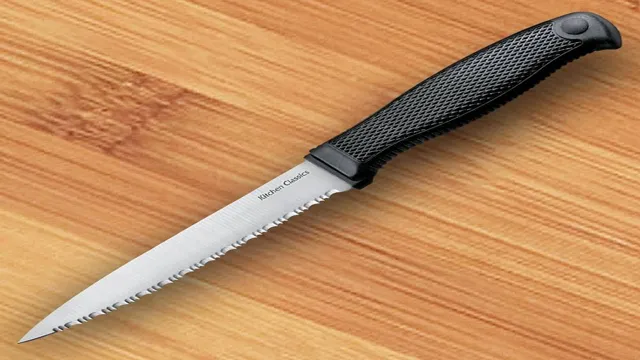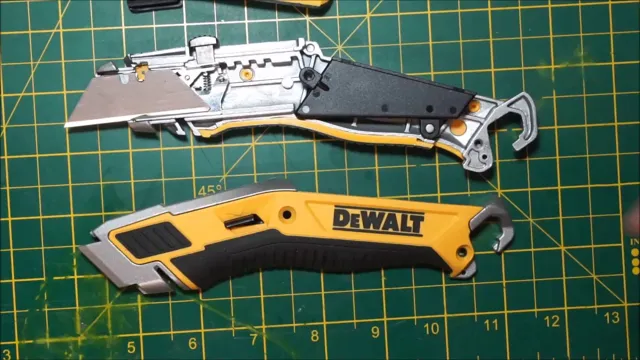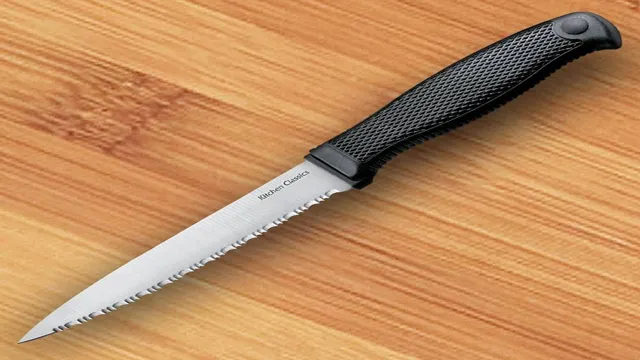How to Close a Folding Utility Knife: A Step-by-Step Guide for Safe Handling

Have you ever struggled with closing a folding utility knife? Maybe you thought you had it figured out, only to end up with a few cuts and bruises? Well, don’t worry, you’re not alone. Many people have had trouble with this seemingly simple task. But fear not, we’re here to help! In this blog post, we will guide you step-by-step on how to safely and efficiently close your folding utility knife, giving you peace of mind every time you use it.
Think of it as a necessary skill for anyone who wants to keep their fingers intact. So, let’s get started!
Steps to Close Knife
Closing a folding utility knife can seem like a daunting task, but with proper technique, it can be done safely and easily. The first step is to ensure that the blade is facing away from your body and any bystanders. Once you have a firm grip on the handle, locate the locking mechanism, which can typically be found on the spine of the knife.
Push the lock away from the blade with your thumb or finger while simultaneously applying pressure to the blade to fold it back into the handle. Be sure to keep your fingers clear of the blade’s path as it folds. Once the blade is entirely back into the handle, release the lock, and give the blade a quick tug to ensure that it is securely locked in place.
With a little practice, you’ll be closing your folding utility knife like a pro in no time!
Step 1: Release the Blade Lock
Closing a knife may seem like a simple task, but it’s important to do it safely to avoid any accidents. The first step in closing a knife is to release the blade lock. This is a safety feature that prevents the blade from accidentally closing on your fingers while in use.
To release the lock, you need to locate the locking mechanism, which is usually located on the side of the handle. Hold the knife handle firmly in one hand and use your other hand to push down on the locking mechanism. Once the lock is released, carefully fold the blade back into the handle until it clicks into place.
Remember to always close your knife when not in use, as leaving it open can cause it to become damaged or cause injury.

Step 2: Fold the Blade into the Handle
To close a folding knife, the next step after releasing the lock is to fold the blade into the handle. This is an essential step to ensure the safety of the knife and prevent any accidental cuts or injuries. To accomplish this, grip the handle firmly with one hand and use the other hand to push the blade inward.
You may need to apply some pressure to overcome the resistance of the spring. Make sure to keep your fingers away from the sharp edge of the blade and take care not to apply too much pressure or force. Once the blade is fully folded into the handle, check that it is secure and locked in place.
This will prevent the blade from accidentally opening and keep you safe while handling the knife. By following these simple steps, you can safely and effectively close your folding knife and prevent any accidents or injuries.
Step 3: Engage the Blade Lock
One of the most important steps in closing a knife is to engage the blade lock. The blade lock is a safety feature that prevents the blade from accidentally opening while the knife is in your pocket or belt. To engage the blade lock, simply locate the lock on the handle and push it towards the blade.
You should hear a clicking sound when the lock is engaged, indicating that the blade is securely locked in place. It’s important to ensure that the blade lock is engaged before storing your knife, as it will prevent any accidental injuries or damage to your knife. With this simple step, you can ensure that your knife is securely closed and ready for its next use.
Common Mistakes to Avoid
Closing a folding utility knife may seem like a no-brainer task, but there are several common mistakes that people make when doing so that can lead to serious injury. The first mistake is failing to push the locking mechanism before attempting to close the blade. This is a critical step that ensures the blade stays securely in place until you’re ready to use it again.
Another mistake that people make is using their fingers to force the blade back into the handle. It’s important to remember that the blade is sharp and can easily slice through skin, so using a cloth or piece of paper to protect your fingers is essential. Finally, it’s important not to rush the process.
Taking your time and effectively closing the knife will prevent accidents from occurring and ensure that the knife remains in good condition for future use. By following these simple steps and avoiding these common mistakes, you can safely and effectively close your folding utility knife every time.
Mistake 1: Not Releasing the Blade Lock
One common mistake people make when using a blade is not releasing the blade lock before attempting to make any adjustments or changes. This may seem like a small oversight, but it can lead to serious injuries. The blade lock is designed to keep the blade securely in place, and releasing it is an important step to ensure that the blade is properly adjusted before cutting.
Not releasing the blade lock can cause the blade to slip or move unexpectedly during use, which could result in serious injury to the user or others in the area. Always take the time to double-check that the blade lock is released before making any changes or using the blade. By doing so, you can help prevent accidents and ensure that your blades are always in good working condition.
Mistake 2: Forcing the Blade to Close
One of the common mistakes that knife users make is forcing the blade to close. This could happen during the closing process, particularly if it seems to be giving some resistance or the blade is new. Forcing the blade could cause it to snap back forcefully, which could lead to injuries to the user or damage to the knife itself.
One way to avoid this mistake is to take some time to learn about your knife’s mechanism, such as its locking mechanism, and to break it in before using it regularly. This could also include applying oil or lubricant to the pivot points and the blade edge to keep it moving smoothly. Remember, even if it seems stubborn, do not use excessive force to close the blade.
Instead, be patient and learn how to handle it until it can be opened and closed quickly and easily. By doing so, you can keep yourself safe while using your knife efficiently and effectively.
Mistake 3: Not Engaging the Blade Lock
One common mistake that people make when using power tools like saws is not engaging the blade lock. It may seem like a small thing, but it can have serious consequences. The blade lock is designed to keep the blade in place, so it doesn’t move while you’re working with the tool.
If the blade isn’t locked in place, it can move unexpectedly, which can be dangerous. Not only can it cause injury, but it can also damage the blade or the tool itself. To avoid this mistake, it’s important to make sure the blade is locked in place before you start using the tool.
It may take an extra second or two, but it’s well worth the effort to ensure your safety and the longevity of your tool. Don’t make the mistake of rushing through the process and neglecting to engage the blade lock. Take your time and stay safe.
Conclusion
Closing a folding utility knife can seem like a daunting task, but fear not! Just like putting down a rebellious teenager, it’s all about applying gentle pressure in the right places. With a flick of the wrist and a slight push, your trusty tool will quickly fold back into its compact form, ready for its next adventure. Don’t let a stubborn knife get the better of you – if at first you don’t succeed, keep calm and knife on!”
FAQs
What is a folding utility knife?
A folding utility knife is a type of versatile and portable cutting tool that can be easily stored in pockets or tool belts, featuring a retractable blade for safety purposes.
How to safely close a folding utility knife?
To safely close a folding utility knife, use your thumb to push the blade back into the handle while keeping your fingers away from the blade’s edge until it is securely retracted.
What are the benefits of using a folding utility knife?
The benefits of using a folding utility knife include its compact size, versatility for various cutting tasks, and safety features such as a retractable blade and secure lock.
How to sharpen a folding utility knife blade?
To sharpen a folding utility knife blade, use a sharpening stone or honing steel at an angle that matches the blade’s existing angle and stroke the blade across the stone or steel several times on each side until it regains its sharpness.
What is the difference between a folding utility knife and a fixed blade knife?
The main difference between a folding utility knife and a fixed blade knife is that the latter’s blade is permanently attached to the handle, while a folding utility knife’s blade can be retracted and folded into the handle for safe and convenient storage.
Can a folding utility knife be used for outdoor activities like camping or hiking?
Yes, a folding utility knife can be a valuable tool for outdoor activities such as camping, hiking, or fishing, thanks to its versatility and compact size.
How to replace the blade on a folding utility knife?
To replace the blade on a folding utility knife, press the blade release button or lock and slide the old blade out. Then, insert the new blade into the slot until it snaps into place, and make sure it is securely fastened before use.







